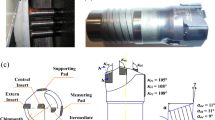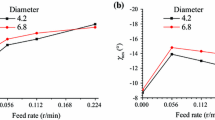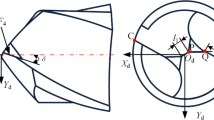Abstract
This paper presents a comprehensive mathematical model for analysis of the geometries of conical, hyperboloidal, and ellipsoidal drills. The proposed method includes three particular features. The first is that a rotational disk-type abrasive wheel is modeled by revolution geometry, thus allowing for the normal and tangent vectors of an abrasive wheel to be obtained explicitly. Consequently, the tangent and normal vectors along the cutting edges and chisel edges of the produced drill can be obtained. The second feature is the ability of the model to determine and express drill geometries and characteristics (semi-point angle, tool cutting edge inclination, chisel angle, normal rake angle and normal clearance angle) according to all current international standards. Thirdly, the drill’s working geometries are investigated by taking the effect of feed motion into consideration. We found that cutting edge geometry can be studied without significant error even though we neglect the effect of feed. The chisel edge working geometry shows greater variation than tool geometry. Consequently, the effect of feed must be taken into consideration when studying chisel edge action during drilling operation.
Similar content being viewed by others
References
Ema S, Fujii H, Marui E, Kato S (1988) New type drill with three major cutting edges. Int J Mach Tools Des Res 28:461–473
Ema S, Fujii H, Marui E (1991) Cutting performance of drills with three cutting edges: effects of chisel edge shapes on the cutting performance. Int J Mach Tools Manuf 31:361–369
Agapiou JS (1993) Design characteristics of new types of drill and evaluation of their performance drilling cast iron II: drills with four major cutting edges. Int J Mach Tools Manuf 33:321–341
Agapiou, JS (1993) Design characteristics of new types of drill and evaluation of their performance drilling cast iron II: drills with three major cutting edges. Int J Mach Tools Manuf 33:343–365
Oxford CJ (1955) On the drilling of metals 1: basic mechanics of the process. Trans ASME 77:103–114
Galloway DF (1957) Some experiments on the influence of various factors on drill performance. Trans ASME 79:191–231
Fujii S, DeVries MF, Wu SM (1970) An analysis of drill geometry for optimum drill design by computer 1: drill geometry analysis. J Eng Ind Trans ASME 92:647–656
Fujii S, DeVries MF, Wu SM (1971) An analysis of the chisel edge and the effect of the d-theta relationship on drill point geometry. J Eng Ind Trans ASME 93:1093–1105
Armarego EJA, Rotenberg A (1973) An investigation of drill point sharpening by the straight lip conical grinding method 1: basic analysis. Int J Mach Tool Des Res 13:155–164
Armarego EJA, Rotenberg A (1973) An investigation of drill point sharpening by the straight lip conical grinding method 2: a criterion for selecting a solution. Int J Mach Tool Des Res 13:165–182
Tasi WD, Wu SM (1979) Computer analysis of drill point geometry. Int J Mach Tools Des Res 19:95–108
Watson, AR (1985) Geometry of drill elements. Int J Mach Tools Des Res 25:209–227
Salama AS, ElSawy AH (1996) The dynamic geometry of a twist drill point. Int J Mater Process Technol 65:45–53
Hsieh JF, Lin PD (2002) Mathematical model of multi-flute drill point. Int J Mach Tools Manuf 42:1181–1193
Boothroyd G (1975) Fundamentals of metal machining and machine tools. McGraw-Hill, New York
Lin C, Kang SK, Ehmann KF (1995) Helical micro-drill point design and grinding. ASME J Eng Ind 117:277–287
Author information
Authors and Affiliations
Corresponding author
Rights and permissions
About this article
Cite this article
Hsieh, JF., Lin, P. Drill point geometry of multi-flute drills. Int J Adv Manuf Technol 26, 466–476 (2005). https://doi.org/10.1007/s00170-003-2027-x
Received:
Accepted:
Published:
Issue Date:
DOI: https://doi.org/10.1007/s00170-003-2027-x




